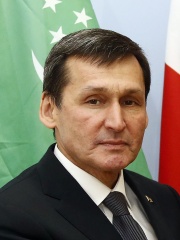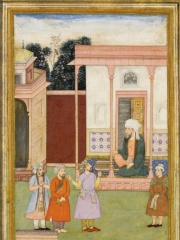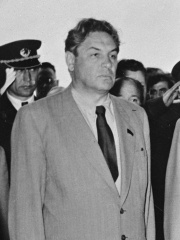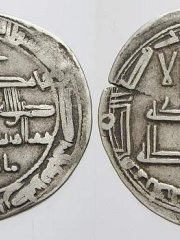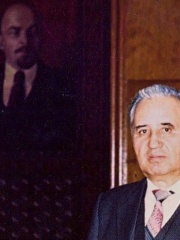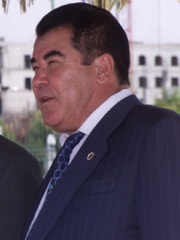
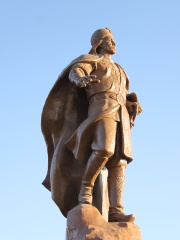
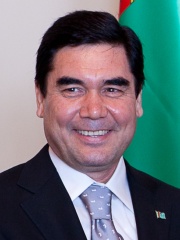
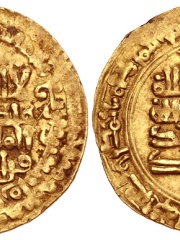

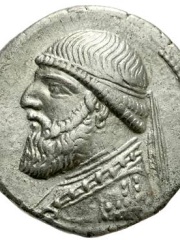
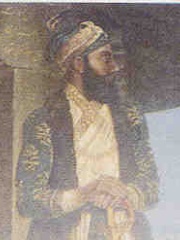
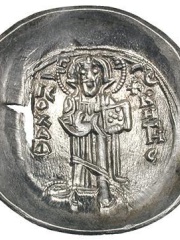
The Most Famous
POLITICIANS from Turkmenistan
This page contains a list of the greatest Turkmen Politicians. The pantheon dataset contains 19,576 Politicians, 16 of which were born in Turkmenistan. This makes Turkmenistan the birth place of the 126th most number of Politicians behind Chad, and Burkina Faso.
Top 10
The following people are considered by Pantheon to be the top 10 most legendary Turkmen Politicians of all time. This list of famous Turkmen Politicians is sorted by HPI (Historical Popularity Index), a metric that aggregates information on a biography's online popularity. Visit the rankings page to view the entire list of Turkmen Politicians.

1. Saparmurat Niyazov (1940 - 2006)
With an HPI of 82.01, Saparmurat Niyazov is the most famous Turkmen Politician. His biography has been translated into 84 different languages on wikipedia.
Saparmurat Atayevich Niyazov (19 February 1940 – 21 December 2006) was a Turkmen politician and dictator who led Turkmenistan from 1985 until his death in 2006. He was the first secretary of the Communist Party of Turkmenistan from 1985 until 1991 and supported the 1991 Soviet coup attempt. He continued to rule Turkmenistan as the first president for 15 years after independence from the Soviet Union in 1991. Turkmen media referred to him using the title His Excellency Saparmurat Türkmenbaşy, President of Turkmenistan and Chairman of the Cabinet of Ministers. His self-given title Türkmenbaşy, meaning Head of the Turkmen, referred to his position as the founder and president of the Association of Turkmens of the World. In 1999, the Assembly of Turkmenistan declared Niyazov to become as President for life. In his time, he was one of the world's most repressive and autocratic dictators. He promoted a cult of personality around himself and imposed his personal eccentricities upon the country, such as renaming Turkmen months and days of the week to references of his autobiography the Ruhnama. He made it mandatory to read the Ruhnama in schools, universities and governmental organizations; new governmental employees were tested on the book at job interviews and an exam on its teachings was a part of the driving test in Turkmenistan. In 2005, he closed down all rural libraries and hospitals outside of the capital city Ashgabat, in a country where at the time more than half the population lived in rural areas, once stating that, "If people are ill, they can come to Ashgabat." Under his rule, Turkmenistan had the lowest life expectancy in Central Asia. Global Witness, a London-based human rights organisation, reported that money under Niyazov's control and held overseas may be in excess of US$3 billion, of which between $1.8–$2.6 billion was allegedly situated in the Foreign Exchange Reserve Fund at Deutsche Bank in Germany.

2. Jalal ad-Din Mingburnu (1199 - 1231)
With an HPI of 75.98, Jalal ad-Din Mingburnu is the 2nd most famous Turkmen Politician. His biography has been translated into 32 different languages.
Jalal al-Din Mangburni (Persian: جلال الدین مِنکُبِرنی), also known as Jalal al-Din Khwarazmshah (جلال الدین خوارزمشاه), was the last Khwarazmshah of the Anushtegin dynasty. The eldest son and successor of Ala ad-Din Muhammad II of the Khwarazmian Empire, Jalal al-Din was brought up at Gurganj, the wealthy capital of the Khwarazmid homeland. An able general, he served as second-in-command to his father in at least one battle; however, since he was the son of a concubine, he was challenged as successor by a younger brother, whose cause was supported by the powerful Queen Mother, Terken Khatun. Nevertheless, after the Mongol conquest of the Khwarazmian Empire led to his father's flight and death on an island in the Caspian Sea, Jalal-al Din gained the loyalty of the majority of Khwarazmian loyalists. The new Shah Jalal al-Din moved to Gurganj, but departed eastwards after Terken Khatun moved against him; evading Mongol patrols, he gathered a substantial army at Ghazni. He managed to inflict an excellent defeat on Shigi Qutuqu at the Battle of Parwan, but soon lost a good portion of his army in a dispute over spoils. He was defeated by a vengeful Genghis Khan at the Battle of the Indus, and fled across the river. Now essentially a warlord, Jalal al-Din managed to establish a succession of short-lived states: first in the Punjab from 1222 to 1224, and then in northwest Iran and Georgia after 1225. Jalal al-Din did not have the political ability needed to underpin his martial exploits, and he was forced to combat several large revolts and increasing pressure from Mongol forces. Eventually, he was killed in 15 August 1231. The army he had gathered would continue to terrorize the Levant as the mercenary Khwarazmiyya until its final defeat in 1246.

3. Gurbanguly Berdimuhamedow (b. 1957)
With an HPI of 72.98, Gurbanguly Berdimuhamedow is the 3rd most famous Turkmen Politician. His biography has been translated into 84 different languages.
Gurbanguly Mälikgulyýewiç Berdimuhamedow (born 29 June 1957) is a Turkmen politician and former dentist who is currently the chairman of the People's Council of Turkmenistan. He previously served as the second president of Turkmenistan from 2006 to 2022, when he entered into a power-sharing arrangement with his son, Serdar, the current president. A former dentist, Berdimuhamedow served in the government of the president, Saparmurat Niyazov, as the minister of health in 1997 and as the deputy cabinet chair in 2001. He became acting president following Niyazow's death on 21 December 2006 and subsequently won the 2007 presidential election. He faced no meaningful opposition and won by an overwhelming margin with 89% of the vote. In 2012, he was re-elected for a second term with 97% of the vote and he was re-elected again in 2017 with 97.7% of the vote. He was among the candidates elected to the People's Council of Turkmenistan on 28 March 2021, as a member from Ahal Region. He reportedly received 100% of votes from the electors. On 14 April 2021, he was unanimously elected chairman of the People's Council, the upper chamber of the Turkmen parliament. Like his predecessor, Berdimuhamedow headed an authoritarian regime and is the subject of a cult of personality. Rights groups have described Turkmenistan under Berdimuhamedow as one of the most repressive countries in the world, accusing Berdimuhamedow, his relatives, and his associates of possessing and exercising unlimited power over all aspects of public life. Berdimuhamedow stepped down as president on 19 March 2022, being succeeded by his son, Serdar, who won a snap election deemed as neither free nor fair, making Turkmenistan the first Central Asian country to be ruled by a dynastic system in modern times. The People's Council was subsequently re-formed as the country's top leadership body in January 2023, with Serdar then reappointing his father as its chairman and granting him the title "National Leader of the Turkmen People".

4. Chaghri Beg (989 - 1060)
With an HPI of 69.15, Chaghri Beg is the 4th most famous Turkmen Politician. His biography has been translated into 25 different languages.
Abu Suleiman Dawud Chaghri Beg ibn Mikail, widely known simply as Chaghri Beg (Turkish: Çağrı Bey, 989–1060), Da'ud b. Mika'il b. Saljuq, also spelled Chaghri, was the co-ruler of the early Seljuk Empire. The name Chaghri is Turkic (Çağrı in modern Turkish) and literally means "small falcon", "merlin".

5. Al-Muqanna (800 - 783)
With an HPI of 68.07, Al-Muqanna is the 5th most famous Turkmen Politician. His biography has been translated into 21 different languages.
Al-Muqanna (Arabic: المقنع "The Veiled", died c. 783) born Hashim, (Arabic: هاشم), was an 8th-century political and military leader who operated in modern Iran. He led a rebellion against the Abbasid Caliphate and according to various Muslim historians, claimed to be a prophet. He was a major figure of the Khorrām-Dīn religious movement, which drew on both Zoroastrian and Islamic influences. Iranian academics Said Nafisi and Amir-Hossein Aryanpour wrote about him in the context of the Khorrām-Dīnān, the religious movement he founded around AD 755.

6. Jaʻfar ibn Yahya (767 - 803)
With an HPI of 66.77, Jaʻfar ibn Yahya is the 6th most famous Turkmen Politician. His biography has been translated into 24 different languages.
Jaʽfar ibn Yahya Barmaki or Jafar al-Barmaki (Persian: جعفر بن یحیی برمکی, Arabic: جعفر بن يحيى, Jaʽfar bin yaḥyā) (767–803), also called Aba-Fadl, was a Persian vizier of the Abbasid caliph Harun al-Rashid, succeeding his father (Yahya ibn Khalid) in that position. He was a member of the influential Barmakid family, formerly Buddhist leaders of the Nava Vihara monastery. He was executed in 803 at the orders of Harun al-Rashid. He had a reputation as a patron of the sciences, and did much to introduce Indian science into Baghdad. He was credited with convincing the caliph to open a paper mill in Baghdad, the secret of papermaking having been obtained from Tang Chinese prisoners at the Battle of Talas (in present-day Kyrgyzstan) in 751.

7. Mithridates II of Parthia (150 BC - 88 BC)
With an HPI of 65.34, Mithridates II of Parthia is the 7th most famous Turkmen Politician. His biography has been translated into 43 different languages.
Mithridates II (also spelled Mithradates II or Mihrdad II; Parthian: 𐭌𐭄𐭓𐭃𐭕 Mihrdāt) was king of the Parthian Empire from 124 to 91 BC. Considered one of the greatest of his dynasty to ever rule, he was known as Mithridates the Great in antiquity. Mithridates II was crowned king after the abrupt death of his predecessor Artabanus I. Inheriting a declining empire that was reeling from military pressure in both the east and west, Mithridates II quickly stabilized the situation in Mesopotamia by gaining the allegiance of Characene, and subduing the insurgent Kingdom of Elymais and also the Arabs, who had continuously raided Babylonia. Mithridates II was the first Parthian king to extend Parthian rule into the Caucasus, where the kingdoms of Armenia, Iberia, and possibly Caucasian Albania became Parthian vassal states. To the east, he defeated and conquered the nomadic tribes in Bactria who had killed both of his predecessors. Sakastan was also reconquered, which was given as a fiefdom to the House of Suren. In 114/113 BC, he seized Dura-Europos in Syria from the Seleucids, and by 95 BC, the northern Mesopotamian kingdoms of Adiabene, Gordyene, and Osrhoene had acknowledged his authority. Under Mithridates II, the Parthian Empire reached it's zenith and extended from Syria and the Caucasus to Central Asia and India. It was under Mithridates II that the Parthian Empire for the first time established diplomatic relations with Rome and Han China. A champion of Achaemenid traditions, Mithridates II was determined to emphasize the association of the ruling Arsacid dynasty with the Iranian Achaemenid Empire. He was the first Parthian monarch to regularly use the title King of Kings, and portray himself with an Iranian tiara on the obverse of his coins, contrary to the Hellenistic diadem used by his earlier predecessors. He also replaced the omphalos on the reverse of his coins with a highbacked throne of Achaemenid origin.

8. Safdar Jang (1708 - 1754)
With an HPI of 63.61, Safdar Jang is the 8th most famous Turkmen Politician. His biography has been translated into 19 different languages.
Asaf Jah Jamat-ul-Mulk Shuja-ud-Daula Nawab Abul Mansur Khan Bahadur Safdar Jang Sipah Salar (c. 1708 – 5 October 1754), better known as Safdar Jang, was the second Nawab of Kingdom of Awadh succeeding Saadat Ali Khan I (his maternal uncle and father-in-law) in the year 1739 and Mughal Grand Vizier from 1748 to 1753. All future Nawabs of Awadh were patriarchal descendants of Safdar Jang. He was a major political figure at the imperial Mughal court during its declining years.

9. Andronikos I of Trebizond (1101 - 1235)
With an HPI of 63.40, Andronikos I of Trebizond is the 9th most famous Turkmen Politician. His biography has been translated into 25 different languages.
Andronikos I Gidos (Greek: Ανδρόνικος Κομνηνός Γίδος, romanized: Andronikos Komnēnos Gidos), Latinized as Andronicus I Gidus or Gidon, was an Emperor of Trebizond (1222–1235). He is the only ruler of Trebizond who was not a blood relative of the founder of that state, Alexios I Megas Komnenos. George Finlay suggests he may be the same Andronikos who was a general of Theodore I Laskaris. During his reign, Trebizond successfully withstood a siege of the city by the Seljuk Turks, and later supported the Khwarazmshah in the latter's unsuccessful battle with the Seljuks.
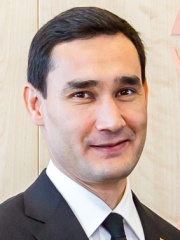
10. Serdar Berdimuhamedow (b. 1981)
With an HPI of 63.30, Serdar Berdimuhamedow is the 10th most famous Turkmen Politician. His biography has been translated into 54 different languages.
Serdar Gurbangulyýewiç Berdimuhamedow (born 22 September 1981) is a Turkmen businessman and politician serving as the third and current president of Turkmenistan since 2022. Berdimuhamedow had previously served in several other positions within the government of his father, Gurbanguly, the long-standing authoritarian ruler of Turkmenistan. The father and son entered into a power-sharing arrangement in 2022, through which they jointly rule a totalitarian dictatorship in Turkmenistan. In 2021, he became one of several deputy chairmen in the Cabinet of Ministers of Turkmenistan. The next year, he won 73 percent of the vote in the country's presidential election, considered to be a sham election, succeeding his father's 18-year-long totalitarian tenure as president and making Turkmenistan the first modern country in Central Asia to be ruled by a dynastic system.
People
Pantheon has 16 people classified as Turkmen politicians born between 150 BC and 1981. Of these 16, 3 (18.75%) of them are still alive today. The most famous living Turkmen politicians include Gurbanguly Berdimuhamedow, Serdar Berdimuhamedow, and Raşit Meredow. The most famous deceased Turkmen politicians include Saparmurat Niyazov, Jalal ad-Din Mingburnu, and Chaghri Beg.
Living Turkmen Politicians
Go to all RankingsGurbanguly Berdimuhamedow
1957 - Present
HPI: 72.98
Serdar Berdimuhamedow
1981 - Present
HPI: 63.30
Raşit Meredow
1960 - Present
HPI: 56.47
Deceased Turkmen Politicians
Go to all RankingsSaparmurat Niyazov
1940 - 2006
HPI: 82.01
Jalal ad-Din Mingburnu
1199 - 1231
HPI: 75.98
Chaghri Beg
989 - 1060
HPI: 69.15
Al-Muqanna
800 - 783
HPI: 68.07
Jaʻfar ibn Yahya
767 - 803
HPI: 66.77
Mithridates II of Parthia
150 BC - 88 BC
HPI: 65.34
Safdar Jang
1708 - 1754
HPI: 63.61
Andronikos I of Trebizond
1101 - 1235
HPI: 63.40
Yahya ibn Khalid
701 - 806
HPI: 62.85
Dmitri Shepilov
1905 - 1995
HPI: 61.57
Ibrahim I ibn al-Aghlab
756 - 812
HPI: 61.18
Muhammetnazar Gapurow
1922 - 1999
HPI: 56.99
Overlapping Lives
Which Politicians were alive at the same time? This visualization shows the lifespans of the 4 most globally memorable Politicians since 1700.

